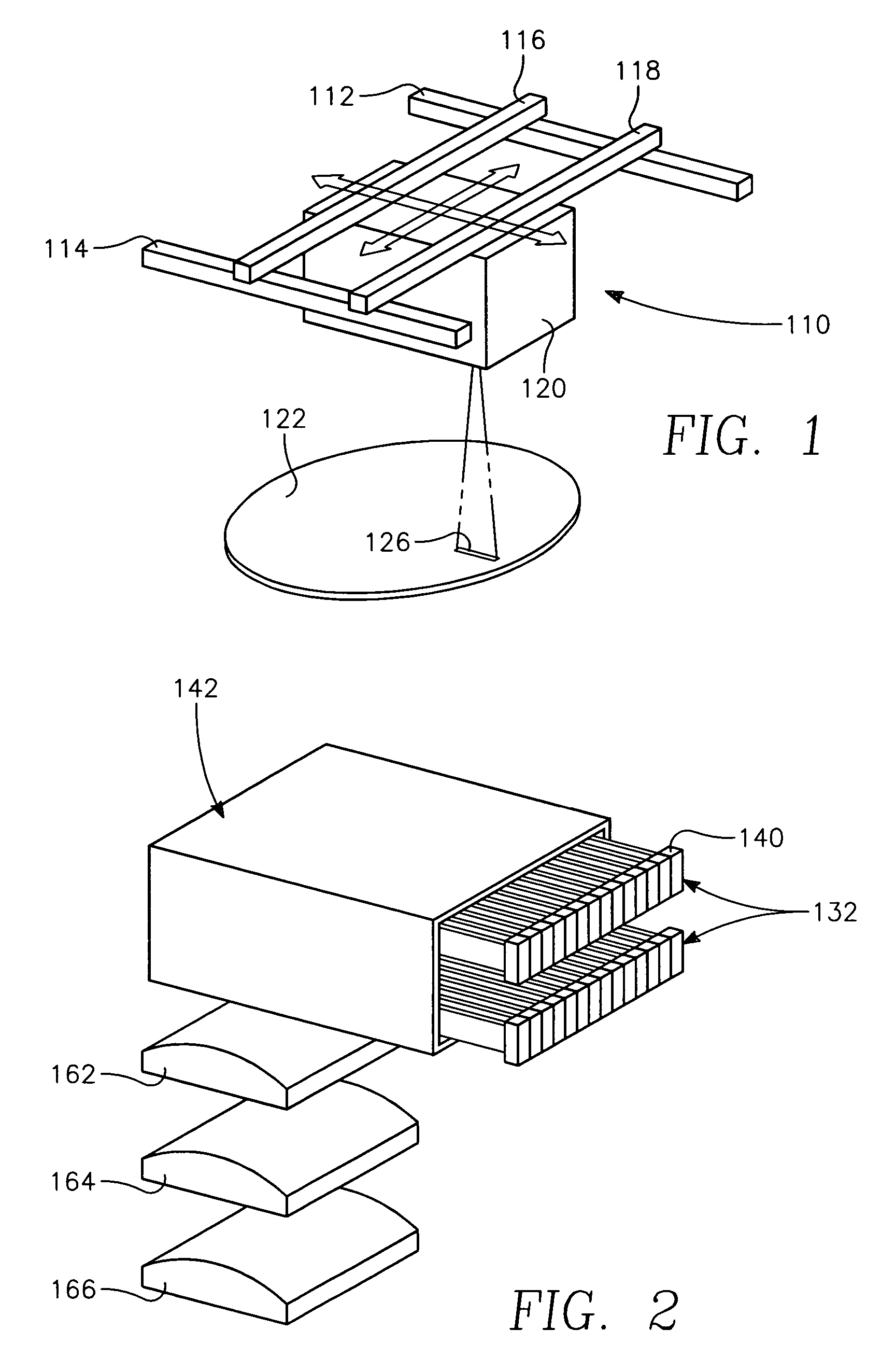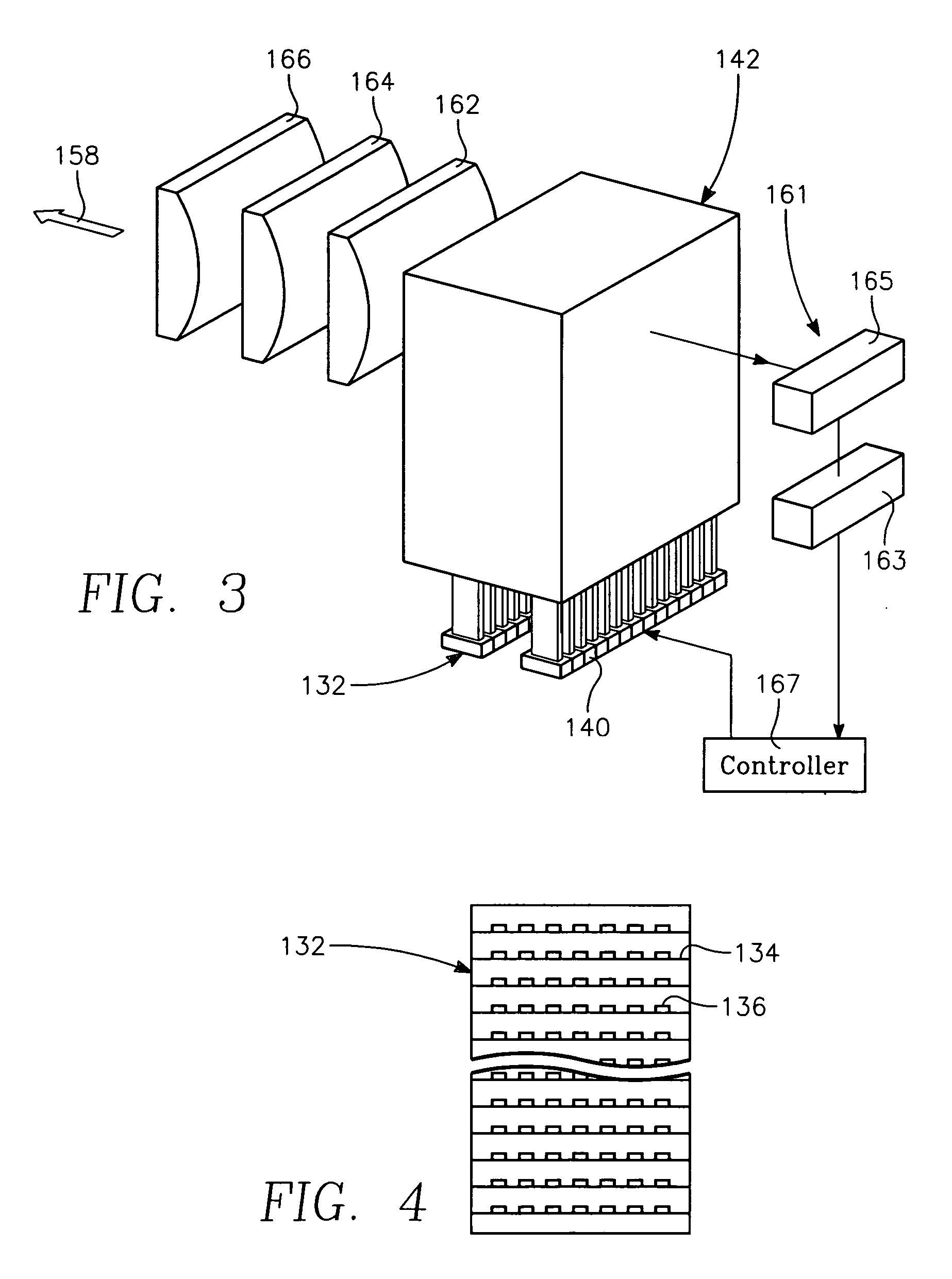However, it is difficult to achieve thermal uniformity over the entire wafer.
Greater thermal non-uniformity within wafer creates significant amount of mechanical stress, resulting in wafer breakage and limits the highest
operating temperature to approximately 1150° C. for anneal using flash lamps.
One problem with RTP is that as device size decreases to 65 nanometers (nm) and below, the minimal thermal
diffusion caused by RTP or flash heating becomes significant relative to the device size, despite the
short duration of the RTP or flash heating.
Another problem is that the degree of activation of the implanted dopant impurities is limited by the
maximum temperature of the RTP or flash process.
Heating the entire wafer volume in the RTP process above the
maximum temperature (e.g., 1100 degrees C.) can create mechanical stresses in the wafer that cause
lattice defects and wafer breakage in extreme cases.
Limiting the wafer temperature to a
maximum level (e.g., 1100 degrees C.) prevents such breakage, but unfortunately limits the proportion of implanted (dopant) atoms that are activated (i.e., that become substitutional in the semiconductor crystalline lattice).
This problem becomes more significant as device size is reduced below 65 nm (e.g., down to 45 nm).
A fundamental problem is that the absorption at 10.6 microns is pattern-dependent because it is affected by the dopant impurities (which among other factors, determines the local
free carrier concentration), so that the wafer surface is not heated uniformly.
Also, conductive or metallic features on the wafer are highly reflective at the 10.6 micron
laser wavelength, so that this process may not be useful in the presence of conductive thin film features.
While the surface heating is extremely rapid and shallow, such pulsed lasers bring the semiconductor
crystal to its
melting point, and therefore the heating must be restricted to an extremely shallow depth, which reduces the usefulness of this approach.
The problem is that the underlying thin film structures formed on the wafer surface present different optical absorption characteristics and different optical emissivities in different locations on the wafer surface.
This makes it difficult if not impossible to attain uniform anneal temperatures across the wafer surface and uniformly accurate temperature measurements across the wafer surface.
This approach has been attempted but has been plagued by problems.
The different
layers in this type of absorber material tend to fuse together under the intense heat of the
laser beam, and become difficult to remove following the
laser anneal step or contaminate underlying
layers with
metal.
One problem is that the deposited layer is vulnerable to
cracking or peeling under the high temperatures of the laser anneal step, unless the layer is deposited at a very high temperature (e.g., 550 degrees C.).
Also the thermal budget (time and temperature) associated with this PECVD
deposition process caused dopants to form clusters which are difficult to dissolve with the subsequent laser anneal step, particularly for feature sizes below 65 nm (such as feature sizes of about 45 nm).
Attempting to solve this problem by reducing the wafer temperature (e.g., to 400 degrees C.) during PECVD deposition of the absorber layer material creates two problems.
First, the thermal properties of the deposited layer are such that it will fail (by
cracking, peeling or separation from the wafer) during the
laser annealing step.
Secondly, the deposited layer that is produced is transparent or has insufficient optical absorption.
Another problem encountered with this absorber layer is that it has poor step coverage.
We feel that failure of the absorber layer (e.g., by peeling or
cracking) arises from a lack of high quality chemical bonds (between the underlying layer and the deposited material) capable of withstanding the stress of being rapidly heated to 1300 degrees C. during the laser anneal step.
Such high
ion energies are not readily attainable in conventional PECVD reactors.
We feel that poor step coverage by the absorber layer or
amorphous carbon layer is the result of the inability of a conventional PECVD or HDPCVD reactor to provide an intermediate range of
ionization (ion-to-radical ratio) with an adequate level of energetic
ion bombardment.
These inadequacies arise, in part, because such conventional PECVD and HDPCVD reactors cannot operate within a wide intermediate range of source
power coupling (to generate plasma electrons),
chamber pressure and wafer
voltage.
Conventional PECVD reactors employ capacitively-coupled RF source power at relatively high-pressure, resulting in a very low range of
ionization (ion-to-radical ratio) with an inadequate level of energetic
ion bombardment (and no separate control of
voltage or energy).
This is due to the inefficient source
power coupling (to generate plasma electrons) and the damping of ion energies by collisions with neutrals at
high pressure.
Even if separate RF biasing of the wafer is added, the damping of ion energies by collisions with neutrals at
high pressure limits the voltage and energy range to a low range.
High energies are not generally attainable due to practical RF
delivery system limitations (RF generators, matching networks, and feed structures).
It is very difficult to remove the heat at low pressure at an adequate rate to maintain low wafer temperature (<400 deg. C. or lower).
Finally, both capacitively-coupled PECVD and inductively-coupled HDPCVD reactors may have
power coupling drift (with on-time) issues when used with carbon
chemistry when depositing absorbing or semiconducting films (on RF windows or insulators).
However, because of the low inter-
electrode voltage and the high loss of
ion energy in the collisional sheath, it is very difficult to generate the
ion energy distribution required for high quality bonds.
As a result,
plasma density and
conductivity is very high, making it difficult to generate a high wafer voltage at practical bias power levels (since the wafer voltage is loaded down through the highly conductive plasma).
As a result, high ion energies cannot be attained without applying excessive amounts of RF bias power to the wafer.
RF power delivery systems >10 kW are very expensive and have limited availability.
Another problem with the HDPCVD reactor is that a large non-conductive window must be provided in the chamber ceiling through which the plasma source power may be inductively coupled from the coil antenna.
This prevents the use of a conductive showerhead directly overlying the wafer, which limits gas
distribution uniformity at the wafer and RF bias ground reference uniformity over the wafer.
The temperature of a non-conductive surface, such as the
dielectric window of the HDPCVD reactor, cannot be effectively controlled, so that deposition during
processing and post-process cleaning of the reactor interior is more difficult.
A related problem in both types of reactors is that plasma source power seeks a ground return from any available conductive surface in the chamber, so that
process control is hampered by electrical changes due to deposition of by-products on the chamber surfaces.
With both
dielectric and
metallic materials constituting the chamber surfaces, removal of deposited plasma by-products after
processing may be difficult or may involve undue wear of chamber parts.
However, such disposable shields cannot provide good RF ground reference nor be thermally controlled with any precision.
Moreover, both types of reactors are susceptible to wide deviations in performance whenever they are used for deposition of non-insulating materials, since the accumulation of non-insulating materials across
electrode boundaries in a capacitively coupled reactor or on the
dielectric window of an inductively coupled reactor will distort or inhibit the
coupling of RF source power into the chamber.
 Login to View More
Login to View More 


